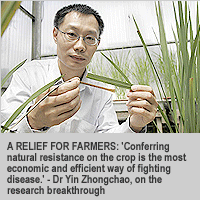The Straits Times - 24 Jun 2006
Singapore breakthough in blight-resistant rice
Researcher comes up with hardy strains by genetic manipulation and cross breeding
By Chang Ai-Lien
SCIENCE CORRESPONDENT
 A SINGAPORE research breakthrough could help the world's rice growers beat a bacterial disease that plagues crops annually. A SINGAPORE research breakthrough could help the world's rice growers beat a bacterial disease that plagues crops annually.
Plant researcher Yin Zhong- chao of the Temasek Life Sciences Laboratory (TLL) has taken a gene from hardy wild rice and placed it into commercial strains that have lost the ability to fight disease.
'Conferring natural resistance on the crop is the most economic and efficient way of fighting disease,' said the assistant director of molecular plant pathology at TLL.
Bacterial blight is the bane of rice farmers, reportedly reducing Asia's annual rice production by up to 60 per cent, according to the International Rice Research Institute.
In India, millions of hectares have been severely infected, it said, causing yield losses of between 6 and 60 per cent.
In an effort to stop such diseases, farmers spend billions on rice herbicides, insecticides and fungicides every year. So cultivating a disease-resistant strain could mean substantial savings apart from being good for the environment.
The TLL has patented the gene - Xa27 - which gives rice the resistance to bacterial blight.
Two large companies - a seed company and a biotechnology firm - have approached the TLL to use the gene to create better rice strains, said Mr Peter Chia, its director of strategic research.
Dr Yin achieved his breakthrough in two ways. First, he created the disease-resistant rice through genetic modification. However, unlike other plants that have been inserted with foreign genes from different species to confer traits such as disease resistance, Dr Yin's rice plants took their new gene from their own species.
In the second way, Dr Yin side-stepped the controversial genetic modification technique by creating the disease-resistant strain through traditional cross-breeding.
Mr Chia said: 'We used the rice gene as a bar code to select which plant has this gene, and bred them with popular rice varieties to create an enhanced commercial strain.'
But rather than pure trial and error, molecular biology allowed them to cut short the process, as researchers simply had to test the new plants to see which had the desired trait.
Dr Yin told The Straits Times that he spent more than two years cross-breeding rice plants over 10 generations before he created the resistant strain.
'The good thing about Singapore is that the weather is ideal for rice, and I can produce five to six generations here, whereas I could get only one or two in certain parts of China,' he said.
His research is part of international efforts to produce better strains of the staple. The research was helped by the mapping of the rice genome - the plant's genetic code - three years ago.
In learning how the plant recognised specific genes in the disease it fought, Dr Yin's team and researchers from Kansas State University in the United States also uncovered a special relationship between a pathogen and its host.
Explaining how blight entered the rice plant, Dr Yin said it used a syringe mechanism to deliver bacteria proteins into the plant cell - a make-or-break time for successful infection.
Plants that possessed the critical Xa27 gene could recognise the invader and imprison it within its fibres so that it perished.
While it is yet unproven, a similar mechanism could be in place in animals and people, he said, which could help scientists better understand the mechanisms that cause disease.
Because of its value in creating a stepping stone for other scientists, Dr Yin's research was published in yesterday's edition of the international scientific journal Nature.
Singapore Press Holdings Limited The Straits Times (Singapore).Copyright 2005
Issued by GMAC
For more information, please contact :
GMAC Secretariat
info@gmac.gov.sg
|